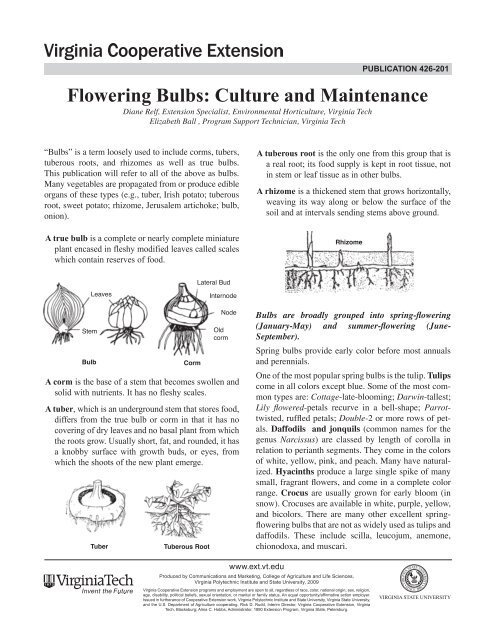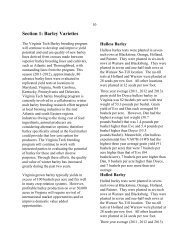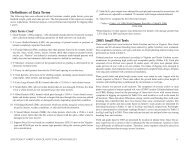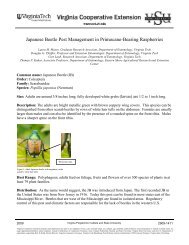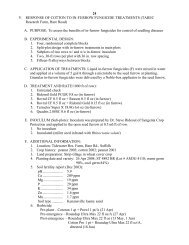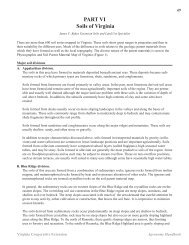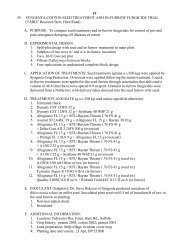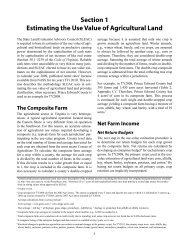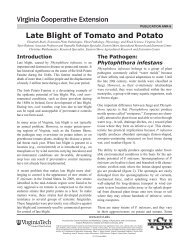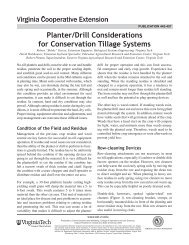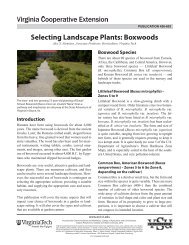Flowering Bulbs: Culture and Maintenance - Virginia Tech
Flowering Bulbs: Culture and Maintenance - Virginia Tech
Flowering Bulbs: Culture and Maintenance - Virginia Tech
Create successful ePaper yourself
Turn your PDF publications into a flip-book with our unique Google optimized e-Paper software.
www.ext.vt.edu<br />
Produced by Communications <strong>and</strong> Marketing, College of Agriculture <strong>and</strong> Life Sciences,<br />
<strong>Virginia</strong> Polytechnic Institute <strong>and</strong> State University, 2009<br />
<strong>Virginia</strong> Cooperative Extension programs <strong>and</strong> employment are open to all, regardless of race, color, national origin, sex, religion,<br />
age, disability, political beliefs, sexual orientation, or marital or family status. An equal opportunity/affirmative action employer.<br />
Issued in furtherance of Cooperative Extension work, <strong>Virginia</strong> Polytechnic Institute <strong>and</strong> State University, <strong>Virginia</strong> State University,<br />
<strong>and</strong> the U.S. Department of Agriculture cooperating. Rick D. Rudd, Interim Director, <strong>Virginia</strong> Cooperative Extension, <strong>Virginia</strong><br />
<strong>Tech</strong>, Blacksburg; Alma C. Hobbs, Administrator, 1890 Extension Program, <strong>Virginia</strong> State, Petersburg.<br />
publication 426-201<br />
<strong>Flowering</strong> <strong>Bulbs</strong>: <strong>Culture</strong> <strong>and</strong> <strong>Maintenance</strong><br />
Diane Relf, Extension Specialist, Environmental Horticulture, <strong>Virginia</strong> <strong>Tech</strong><br />
Elizabeth Ball , Program Support <strong>Tech</strong>nician, <strong>Virginia</strong> <strong>Tech</strong><br />
“<strong>Bulbs</strong>” is a term loosely used to include corms, tubers,<br />
tuberous roots, <strong>and</strong> rhizomes as well as true bulbs.<br />
This publication will refer to all of the above as bulbs.<br />
Many vegetables are propagated from or produce edible<br />
organs of these types (e.g., tuber, Irish potato; tuberous<br />
root, sweet potato; rhizome, Jerusalem artichoke; bulb,<br />
onion).<br />
A true bulb is a complete or nearly complete miniature<br />
plant encased in fleshy modified leaves called scales<br />
which contain reserves of food.<br />
Stem<br />
Leaves<br />
Bulb Corm<br />
Tuber<br />
Tuberous Root<br />
Lateral Bud<br />
Internode<br />
Node<br />
Old<br />
corm<br />
A corm is the base of a stem that becomes swollen <strong>and</strong><br />
solid with nutrients. It has no fleshy scales.<br />
A tuber, which is an underground stem that stores food,<br />
differs from the true bulb or corm in that it has no<br />
covering of dry leaves <strong>and</strong> no basal plant from which<br />
the roots grow. Usually short, fat, <strong>and</strong> rounded, it has<br />
a knobby surface with growth buds, or eyes, from<br />
which the shoots of the new plant emerge.<br />
A tuberous root is the only one from this group that is<br />
a real root; its food supply is kept in root tissue, not<br />
in stem or leaf tissue as in other bulbs.<br />
A rhizome is a thickened stem that grows horizontally,<br />
weaving its way along or below the surface of the<br />
soil <strong>and</strong> at intervals sending stems above ground.<br />
Rhizome<br />
<strong>Bulbs</strong> are broadly grouped into spring-flowering<br />
(January-May) <strong>and</strong> summer-flowering (June-<br />
September).<br />
Spring bulbs provide early color before most annuals<br />
<strong>and</strong> perennials.<br />
One of the most popular spring bulbs is the tulip. Tulips<br />
come in all colors except blue. Some of the most common<br />
types are: Cottage-late-blooming; Darwin-tallest;<br />
Lily flowered-petals recurve in a bell-shape; Parrottwisted,<br />
ruffled petals; Double-2 or more rows of petals.<br />
Daffodils <strong>and</strong> jonquils (common names for the<br />
genus Narcissus) are classed by length of corolla in<br />
relation to perianth segments. They come in the colors<br />
of white, yellow, pink, <strong>and</strong> peach. Many have naturalized.<br />
Hyacinths produce a large single spike of many<br />
small, fragrant flowers, <strong>and</strong> come in a complete color<br />
range. Crocus are usually grown for early bloom (in<br />
snow). Crocuses are available in white, purple, yellow,<br />
<strong>and</strong> bicolors. There are many other excellent springflowering<br />
bulbs that are not as widely used as tulips <strong>and</strong><br />
daffodils. These include scilla, leucojum, anemone,<br />
chionodoxa, <strong>and</strong> muscari.
Summer-flowering bulbs include amaryllis, canna, tuberous<br />
begonia, caladium, daylily, dahlia, gladiolus, lily, <strong>and</strong><br />
spider lily.<br />
<strong>Culture</strong><br />
Selecting bulbs. Selecting quality spring bulbs is very<br />
important, because the flower bud has already developed<br />
before the bulb is sold. Size is also important;<br />
look for plump, firm bulbs. Select on a basis of<br />
color <strong>and</strong> size for intended purposes; for example,<br />
small ones for naturalizing <strong>and</strong> large ones to st<strong>and</strong><br />
out as specimen plants.<br />
Storage. If bulbs are bought before planting time,<br />
keep them in a cool, dry place. A temperature of 60˚<br />
to 65˚F is cool enough to prevent bulbs from drying<br />
out until time for planting. Temperatures higher<br />
than 70˚F will damage the flower inside springflowering<br />
bulbs. Rhizomes, tubers, <strong>and</strong> tuberous<br />
roots are more easily desiccated than bulbs <strong>and</strong><br />
corms, <strong>and</strong> should be stored in peat, perlite, or vermiculite.<br />
Site Selection. In selecting a site for planting, consider<br />
light, temperature, soil texture, <strong>and</strong> function.<br />
Most bulbs need full sun. Select a planting site that<br />
will provide at least 5 to 6 hours of direct sunlight a<br />
day. <strong>Bulbs</strong> left in the ground year after year should<br />
have 8 to 10 hours of daily sunlight for good flowering.<br />
<strong>Bulbs</strong> planted in a southern exposure near a<br />
building or wall will bloom earlier than bulbs planted<br />
in a northern exposure. Adequate drainage is an<br />
important consideration. Most bulbs <strong>and</strong> bulb-like<br />
plants will not tolerate poor drainage, <strong>and</strong> rot easily<br />
if planted in wet areas. Function must also be kept<br />
in mind. If bulbs are being used to naturalize an<br />
area, toss the bulbs then plant them where they fall<br />
to create a scattered effect.<br />
Site Preparation. Good drainage is the most important<br />
single factor for successful bulb growing. Bulb<br />
beds should be dug when the soil is fairly dry. Wet<br />
soil packs tightly <strong>and</strong> retards plant growth. Spade<br />
the soil 8 to 12 inches deep. As you dig, remove<br />
large stones <strong>and</strong> building trash, but turn under all<br />
leaves, grass, stems, roots, <strong>and</strong> anything else that<br />
will decay. Add fertilizer <strong>and</strong> organic matter to the<br />
soil. Use 1 pound of 5-10-10 fertilizer for a 5 by 10<br />
foot area, or a small h<strong>and</strong>ful for a cluster of bulbs.<br />
Place a 1 to 2 inch layer of organic matter over the<br />
bed. Thoroughly mix the fertilizer <strong>and</strong> organic matter<br />
with the soil. For individual planting holes,<br />
loosen the soil below the depth the bulb is to be<br />
planted. Add fertilizer <strong>and</strong> cover with a layer of soil<br />
(bulbs should not contact fertilizers directly). Set<br />
the bulb upright in the planting hole <strong>and</strong> cover with<br />
amended soil. In wet, hot summers, organic fertilizer<br />
may retard blooming <strong>and</strong> promote disease, es-<br />
2<br />
pecially with gladiolus. If voles are a problem, the<br />
bulbs can be planted in baskets made of wire screen<br />
to prevent the animals from reaching <strong>and</strong> destroying<br />
them.<br />
Time of Planting. Hardy, spring-flowering bulbs are<br />
planted in fall. Hardy, fall-flowering bulbs, such as<br />
colchicum, are planted in August. Tender, summerflowering<br />
bulbs are planted in the spring after danger<br />
of frost. Lilies are best planted in late fall.<br />
Depth of Planting. It is best to check correct planting<br />
depth for each bulb with a successful local grower<br />
or other good local source. Bulb catalog <strong>and</strong> reference<br />
book recommendations for planting may be<br />
either too shallow or too deep depending on soil<br />
condition. As a general rule of thumb, bulbs should<br />
be planted 2 1/ 2 to 3 times the diameter of the bulb in<br />
depth. It is important not to plant bulbs too shallow,<br />
as this will encourage frost heaving.<br />
<strong>Maintenance</strong><br />
Watering. Normal rainfall usually provides enough<br />
moisture for bulbs. However, during dry weather,<br />
water plants at weekly intervals, soaking the ground<br />
thoroughly. Be especially careful not to neglect<br />
bulbs after blooming.<br />
Mulching. In the winter, mulch bulbs 2 to 4 inches<br />
deep with organic material such as straw, pine bark,<br />
hay, or ground leaves. Do not use large leaves, as<br />
they may mat too tightly on the ground. A winter<br />
mulch prevents alternate freezing <strong>and</strong> thawing,<br />
which damages bulbs <strong>and</strong> plant roots. Apply mulch<br />
after cold weather arrives. You may damage the<br />
bulbs if you mulch while soil temperature is still<br />
high. Remove mulch as soon as danger of severe<br />
freezing has passed in early spring. If mulch is left<br />
on the ground after new growth starts, tops of new<br />
shoots will be pale green or colorless <strong>and</strong> new stems<br />
<strong>and</strong> foliage may be broken.<br />
Fertilizing. After plants bloom, fertilize them lightly<br />
with 5-10-10 fertilizer. Use no more than 1 pound<br />
for a 5 by 10 foot bed. Avoid high-nitrogen fertilizer<br />
(N is the first of the 3 numbers). Be sure to keep<br />
fertilizer off the leaves <strong>and</strong> away from roots; it will<br />
burn them. In addition to 5-10-10 fertilizer, you can<br />
use bonemeal as an extra source of phosphorus.<br />
Staking. Some tall, heavy-flowered bulbs may require<br />
staking. Stake plants when they are emerging, but<br />
be careful not to damage the bulb with the stake.<br />
Deadheading. When flowers fade, cut them off to<br />
prevent seed formation. Seeds take stored food from<br />
the bulbs.<br />
Removing foliage. If leaving bulbs in place for bloom<br />
next year, do not cut the leaves after flowering until<br />
they start to wither. Green leaves produce food for
plant growth next year. After leaves turn yellow, cut<br />
<strong>and</strong> destroy the stems <strong>and</strong> foliage of the plants.<br />
Dead foliage left on the ground may carry disease to<br />
new growth the next year. <strong>Bulbs</strong> naturalized in<br />
lawns are unfortunately subject to mowing which<br />
can be very harmful. <strong>Bulbs</strong> need their foliage left<br />
intact until it has turned brown in order to build<br />
strong bulbs for the next year’s flowers. Avoid<br />
mowing or covering the foliage before it matures<br />
naturally.<br />
Moving. If moving bulbs from one place to another,<br />
or if a planting has become crowded <strong>and</strong> ceased<br />
blooming, move only after the foliage has faded.<br />
<strong>Bulbs</strong> dug <strong>and</strong> moved before foliage fades may not<br />
bloom for several years.<br />
Digging <strong>and</strong> Storing. In parts of <strong>Virginia</strong>, many<br />
summer-flowering bulbs should be dug <strong>and</strong> stored,<br />
as they are tender. This is done when the leaves on<br />
the plants turn yellow, before danger of freeze damage.<br />
Use a spading fork to lift the bulbs from the<br />
ground. Wash off any soil that clings to the bulbs,<br />
except those that are stored in pots or with the soil<br />
around them. Spread the washed bulbs in a shaded<br />
place to dry. When dry, store them away from sunlight<br />
in a cool, dry basement, cellar, garage, or shed<br />
at 50° to 60°F. Avoid temperatures below 50°F or<br />
above 70°F. Be sure that air circulates around stored<br />
bulbs. Never store bulbs more than two or three layers<br />
deep, as they can generate heat which causes<br />
decay. Leave the soil on begonia, canna, caladium,<br />
<strong>and</strong> dahlia bulbs. Store these bulbs in clumps on a<br />
slightly moistened layer of peat moss or sawdust in<br />
a cool place. Rinse, clean, <strong>and</strong> separate them just<br />
before planting.<br />
Original publication reviewed by Holly Scoggins, <strong>Virginia</strong><br />
<strong>Tech</strong> Department of Horticulture; Joyce Latimer,<br />
<strong>Virginia</strong> <strong>Tech</strong> Department of Horticulture; <strong>and</strong> Dawn<br />
Alleman, <strong>Virginia</strong> Cooperative Extension, Norfolk<br />
Office.<br />
Reviewed by Suzanne Piovano, laboratory specialist, Horticulture<br />
3


